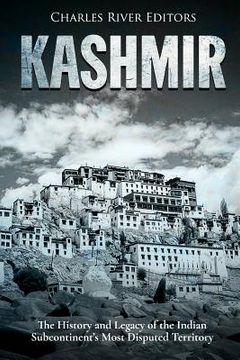Kashmir: The History and Legacy of the Indian Subcontinent's Most Disputed Territory (en Inglés)
Reseña del libro "Kashmir: The History and Legacy of the Indian Subcontinent's Most Disputed Territory (en Inglés)"
*Includes pictures *Includes online resources and a bibliography for further reading After the Sepoy Rebellion, India was governed directly from England through a dedicated department: the India Office, headed by the Secretary of State for India. The territory was divided into "British India", which came under direct British control, and the Princely States. The latter were the territories and sovereignties of various powerful tradition leaders, remnants of the old system of rule, who were permitted, under various weights of British superintendentship, to maintain their positions and continue their rule. British India ultimately covered some 54 percent of the landmass and 77 percent of the population. By the time the British began to contemplate a withdrawal from India, 565 princely states were officially recognized, in addition to thousands of zamindaris and jagirs, which were in effect feudal estates. The stature of each Princely State was defined by the number of guns fired in salute upon a ceremonial occasion honoring one or other of the princes. These ranged from nine-gun to twenty-one-gun salutes and, in a great many cases, no salute at all. The Princely States were reasonably evenly spread between ancient Muslim and Hindu dynasties, but bearing in mind the minority status of Muslims in India, Muslims were disproportionately represented. This tended to grant Muslims an equally disproportionate share of what power was devolved to local leaderships, and it positioned powerful Muslim leaders to exert a similarly unequal influence on British policy. It stands to reason, therefore, as India began the countdown to independence after World War II, that the Indian Muslim leadership would begin to express anxiety over the prospect of universal suffrage and majority rule. At less than 20 percent of the population, Indian Muslims would inevitably find themselves overwhelmed by the Hindu majority, and as the British prepared to divest themselves of India, ancient enmities between Hindu and Muslim, long papered over by the secular and remote government of Britain, began once again to surface. At the heart of the geopolitical dispute that resulted is Kashmir, which has often been described as the most beautiful place on earth, but also the most dangerous. Nestled between the Karakoram mountains to the north and the Himalayas to the south, the Vale of Kashmir is a place of mythic beauty, in part the inspiration for James Hilton's Shangri-La, and certainly one of the most unspoiled and lovely regions of South Asia. It also, however, happens to be the fault line of a bitter conflict between two major regional powers, India and Pakistan, who both lay claim its central valley, and its wide and mountainous hinterland. Kashmir, or Jammu and Kashmir, as it is marked on modern maps, sits more or less midway along a vast geographic and cultural boundary that stretches from the Caspian Sea to northern Myanmar, and which through history has separated south from central Asia. South of this region, at the turn of the 19th century, lay India, not quite yet a unified concept, and ruled largely by a collection of princely states, part of the declining Mughal Empire, and the British East India Company. Over, and within this disputed territory, the two nations have fought three wars and numerous skirmishes. If, however, a major, all-out war breaks out in this region, between two powers armed with nuclear weapons, as has often been threatened, a global catastrophe might easily erupt in one of the most populous regions on earth. Kashmir: The History and Legacy of the Indian Subcontinent's Most Disputed Territory chronicles the remarkable history of the area and the influence it has had over the centuries. Along with pictures depicting important people, places, and events, you will learn about Kashmir like never before.

